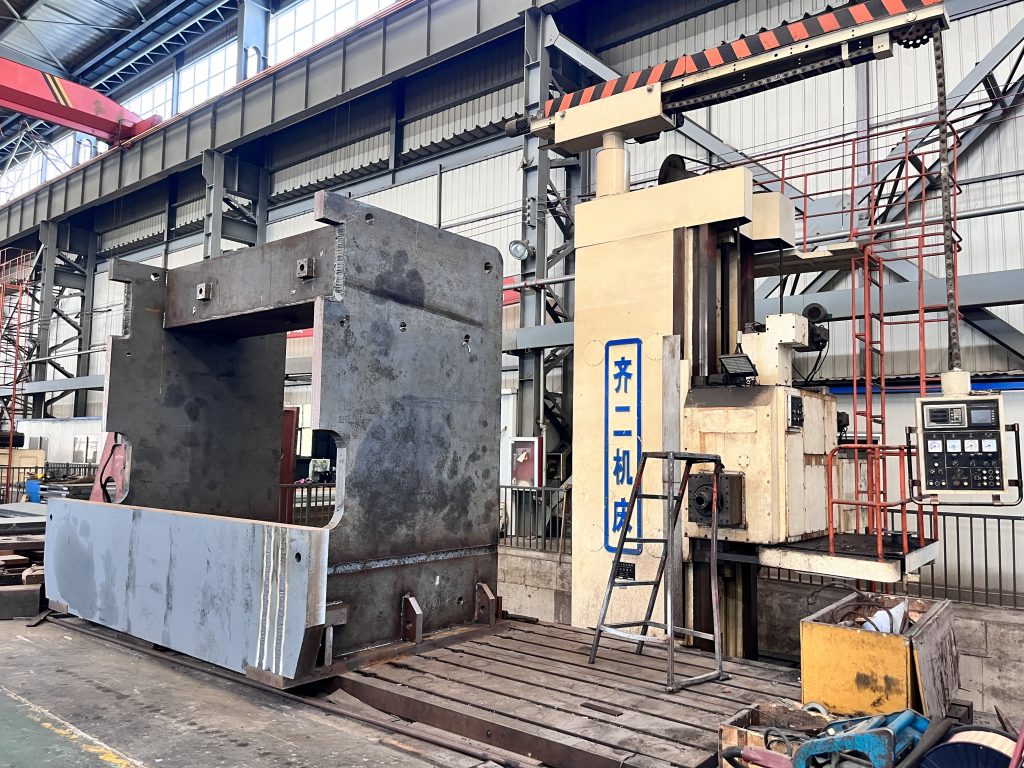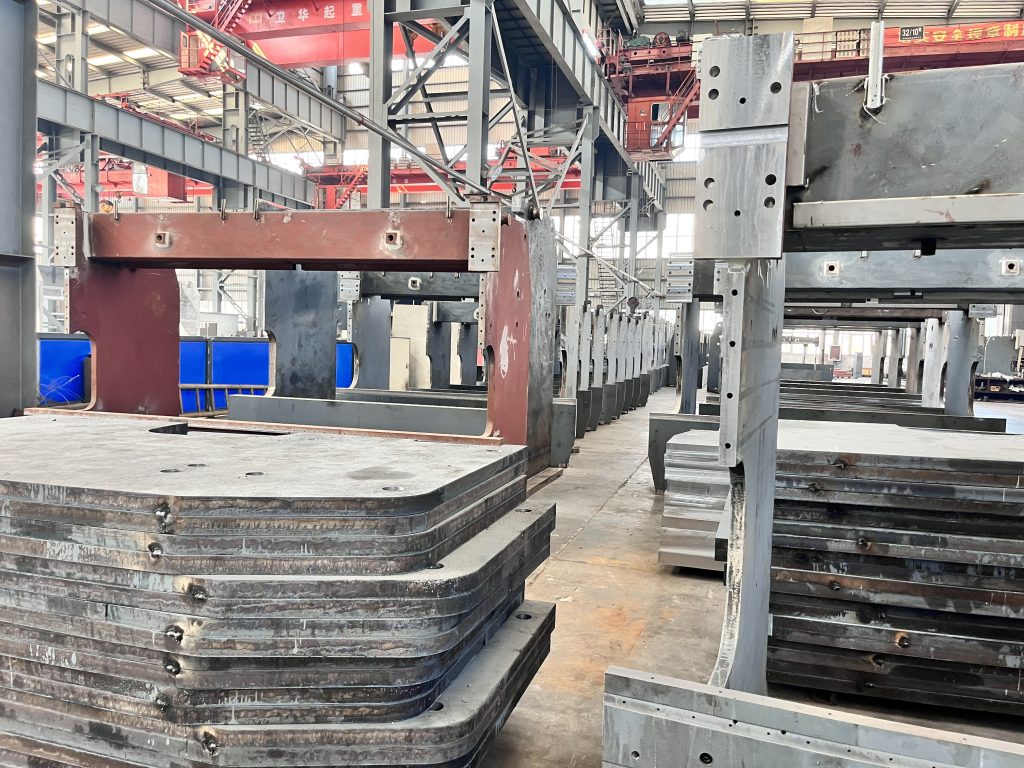¡Llámenos hoy!+86 18055583040|admin@zymtcnc.com

¡Llámenos hoy!+86 18055583040|admin@zymtcnc.com

1. Accuracy assurance:
The frame processed as a whole can ensure that the dimensional accuracy of each installation surface and key parts is highly consistent. During the operation of the bending machine, the relative position accuracy of the tool and the workpiece is crucial. If the frame is not processed as a whole, but is spliced with multiple parts, even if precise adjustments are made during assembly, it is difficult to avoid the accuracy deviation caused by factors such as small gaps and deformations in the connection parts. The overall processing can control this accuracy error within a very small range, thereby improving the accuracy of the bending.
For example, when bending some metal sheets with high precision requirements, the deviation of the bending angle may need to be controlled within a very small degree. The frame processed as a whole can better meet this high-precision requirement.
2. Enhanced stability:
The bending machine will be subjected to greater pressure and impact when working. The frame processed as a whole has higher structural strength and rigidity, which can better resist the effects of these external forces and reduce the deformation and vibration of the frame.
In contrast, when the spliced rack is subjected to a large load, the connection parts are prone to loosening and displacement, which affects the stability and processing quality of the bending machine. For example, when bending thick plates, a large pressure is required. If the rack is unstable, it may cause problems such as uneven bending angles and indentations on the surface of the plate.
1. Simplify the assembly process:
The overall processed rack does not require complex assembly and debugging of multiple parts during assembly, which greatly simplifies the assembly process and reduces the difficulty and cost of assembly.
At the same time, due to the reduction of assembly links, the risk of failure caused by improper assembly is also reduced.
2. Eliminate assembly errors:
During the assembly process, the rack spliced with multiple parts will inevitably have assembly errors. These errors may come from the manufacturing accuracy of the components, assembly process, etc. Even with high-precision processing and assembly technology, it is difficult to completely eliminate these errors. The overall processed rack does not have assembly errors, thereby improving the overall performance and reliability of the bending machine.
1. Reduce wear:
The overall processed frame has high surface flatness and good matching accuracy of each part, which can reduce friction and wear between moving parts. For example, the matching between the slider and the guide rail of the bending machine, if the frame accuracy is not high, may cause the slider to move unsmoothly, increase wear, and thus reduce the service life of the equipment.
2. Enhance corrosion resistance:
The overall processed frame can be treated with a more uniform surface to improve the corrosion resistance of the frame. In some harsh working environments, such as humid and corrosive gas environments, corrosion resistance is crucial to extend the life of the equipment.
In summary, the use of an overall processed frame for the bending machine can improve accuracy and stability, reduce assembly errors, and increase equipment life, thereby better meeting the needs of various bending processes.

1. High precision: The integral processing can ensure that the dimensional accuracy of each installation surface and key parts is highly consistent, reduce the accuracy deviation caused by the small gap and deformation of the connection parts, improve the bending accuracy, and meet the high-precision bending needs.
2. Good stability: It has higher structural strength and rigidity, can better resist the pressure and impact force during work, reduce deformation and vibration, and is more stable than the spliced frame to ensure processing quality.
3. Easy assembly: There is no need for complex assembly and debugging of multiple parts during assembly, which simplifies the assembly process, reduces the difficulty and cost of assembly, and also reduces the risk of failure caused by improper assembly.
4. Long equipment life: High surface flatness and good matching accuracy can reduce friction and wear between moving parts; more uniform surface treatment can be performed, improve corrosion resistance, and extend the service life of the equipment.
5. Reliable performance: There is no assembly error, the overall performance is more reliable, and the accuracy and stability during work are better, reducing equipment failures caused by frame problems.
1. High cost: The overall processing requires advanced processing equipment and technology, which is difficult to process, consumes more materials and processing time, resulting in high manufacturing costs, which in turn makes the whole machine more expensive.
2. Inconvenient transportation: The overall size and weight of the frame are large, which may be restricted during transportation, and special transportation tools and methods are required, which increases the transportation cost and difficulty.
3. Complex maintenance: If there is a problem or damage to the frame, the maintenance is relatively complicated, and professional technicians and equipment may be required for repair, and the maintenance time and cost will also be high.
In-depth search

1. Machinery manufacturing industry:
Parts processing: used to manufacture metal parts of various types of machinery, such as machine tool housings, transmission shafts, gears, etc., which can ensure the high precision and high stability of parts and meet the strict requirements of mechanical assembly. For example, in the manufacturing of automobile engines, the processing of engine cylinders, crankshafts and other parts, the bending accuracy directly affects the performance and quality of the engine.
Mold manufacturing: In the mold production process, it is often necessary to bend the mold template, bracket and other parts. The bending machine with an integral processing frame can ensure the dimensional accuracy and shape accuracy of the mold parts, thereby improving the overall quality and service life of the mold. For example, the cavity plate of the injection mold and the convex and concave mold fixing plate of the stamping mold all require high-precision bending processing to ensure the normal operation of the mold.
2. Automobile manufacturing industry:
Body structure processing: The structural parts of the automobile body, such as the frame, door, side panel, etc., usually need to be bent to form a specific shape and angle. The bending machine with an integral processing frame can meet the requirements of high precision, high strength and high consistency of the automobile body structural parts, and ensure the overall quality and safety of the car body. For example, some high-end car brands use bending machines with integral processing frames in body manufacturing to ensure the accuracy and quality of body structural parts and improve the performance and safety of the car.
Auto parts production: Auto parts such as exhaust pipes, dashboard brackets, seat frames, etc. also need to be bent. The shapes and sizes of these parts are different. The bending machine of the integral processing frame can flexibly adapt to the processing requirements of different parts, while ensuring the processing accuracy and quality, and improving the production efficiency and reliability of automotive parts.
3. Aerospace industry:
Aircraft parts manufacturing: The key parts of the aircraft, such as wings, fuselage frames, landing gears, etc., have extremely high requirements for bending accuracy and quality. The bending machine of the integral processing frame can ensure the high-precision bending of these parts to ensure the structural strength and flight safety of the aircraft. For example, in the manufacture of aircraft wings, the skin and reinforcement ribs of the wings need to be precisely bent to ensure the aerodynamic shape and structural strength of the wings.
Aerospace equipment production: Rocket shells, satellite structural parts, etc. in aerospace equipment also require high-precision bending processing. The bending machine of the integral processing frame can meet the strict requirements of aerospace equipment for the accuracy and reliability of parts, and provide support for the development of the aerospace industry. For example, the solar panel bracket of the satellite needs to be bent to form a specific angle and shape to ensure the best lighting effect of the solar panel.
4. Electronic equipment manufacturing industry:
Chassis cabinet processing: The shells of electronic equipment such as computer cases, server cabinets, and communication equipment cabinets usually need to be bent to form space for internal electronic components. The bending machine of the integral processing rack can ensure the dimensional accuracy and stability of the shell, and provide good protection and heat dissipation conditions for electronic equipment. For example, the manufacturing of some high-end server cabinets uses a bending machine with an integral processing rack to ensure the accuracy and quality of the cabinet and improve the stability and reliability of the server.
Electronic component production: Some small components in electronic equipment, such as circuit board brackets and connector shells, also need to be bent. The bending machine of the integral processing rack can meet the processing requirements of these small-sized, high-precision components and improve the production efficiency and quality of electronic equipment. For example, some metal components inside electronic products such as mobile phones and tablets need to be bent to achieve specific functions and structures.
5. Construction industry:
Building metal structural parts production: In the construction industry, metal structural parts such as steel beams, steel columns, and steel trusses of steel structure buildings need to be bent to meet the requirements of architectural design. The bending machine of the integral processing rack can ensure the bending accuracy and quality of these large metal structural parts, and ensure the structural stability and safety of the building. For example, the construction of some large stadiums, exhibition centers and other steel structure buildings requires the use of bending machines with integral processing racks to process steel structural parts.
Decorative metal material processing: Metal materials commonly used in architectural decoration, such as stainless steel plates, aluminum plates, etc., need to be bent to make various decorative lines, curtain wall panels, etc. The bending machine of the integral processing rack can achieve high-precision bending of these decorative materials to meet the requirements of architectural decoration for beauty and quality. For example, the curtain wall decoration of buildings such as hotels and shopping malls often uses bent metal plates to achieve unique design effects.
6. Kitchenware manufacturing industry:
Kitchen equipment production: The metal parts of kitchen cabinets, stoves, sinks and other equipment need to be bent to form specific shapes and structures. The bending machine of the integral processing rack can ensure the dimensional accuracy and surface quality of these kitchenware parts, and improve the beauty and practicality of kitchen equipment. For example, the cabinet body and door panels of stainless steel cabinets need to be bent to achieve different shapes and functions.
Tableware manufacturing: Some metal tableware, such as knives, forks, spoons, etc., also need to be bent to form specific shapes and angles. The bending machine with an integral processing frame can meet the requirements of tableware manufacturing for high precision and high efficiency, and improve the production quality and efficiency of tableware.